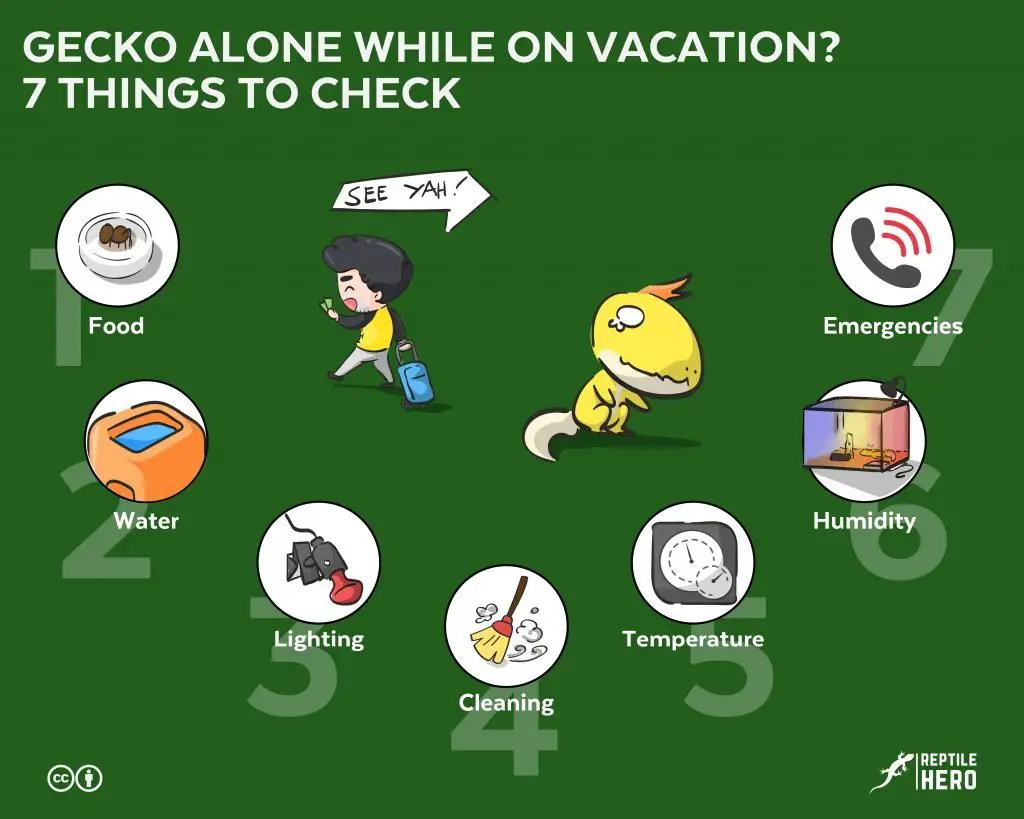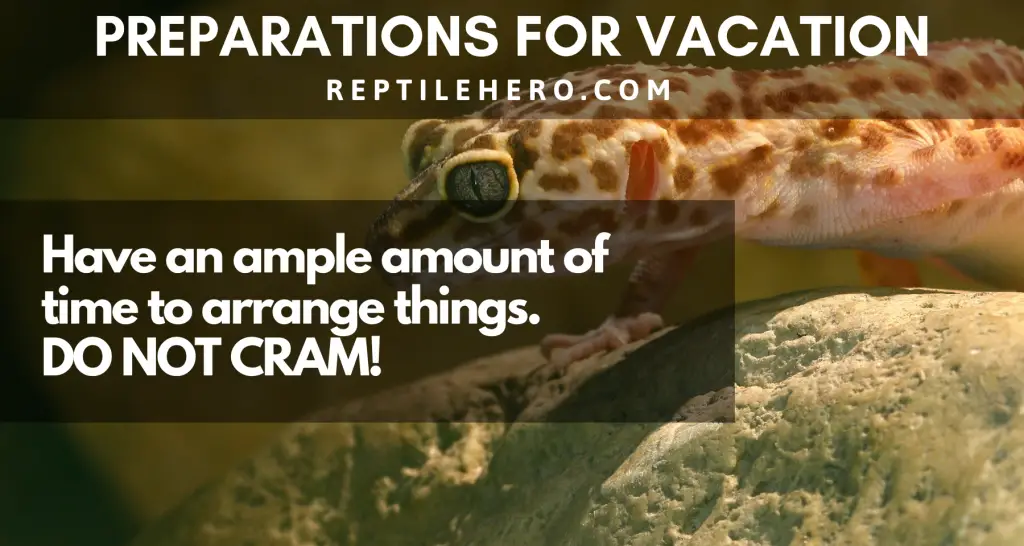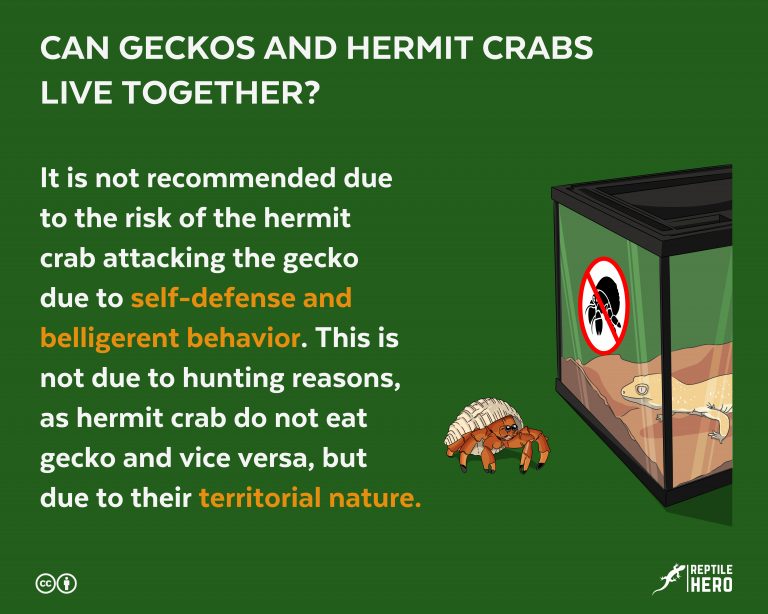Gecko Alone While On Vacation? [7 Things To Check]
Are you excited to go have some fun on your upcoming vacation? Have you packed all your essentials and double-checked your itinerary and bookings? If yes, that is good! But wait, are you sure you have not forgotten anything? What about your gecko?
If away on vacation, a full-stomach leopard or crested gecko can easily survive 2–4 days depending on their age. Before departure, it is vital to guarantee that the following are either automatically controlled or provided:
- Food
- Water
- Lighting
- Cleaning
- Temperature
- Humidity
- Emergencies
Do not worry. Just keep scrolling further down for the details.
Expecting a Vacation: Should You leave your gecko alone?
Depending on your situation, leaving your reptile may hinder your excitement. However, with the most suitable and applicable method, you may lessen the burden you will feel.
If they have no other choice, adult reptiles, including leopard and crested geckos, can survive up to 14 days without food inside a tank with a bowl filled with water. While this is true, your healthy gecko may find this circumstance unideal and equally unpleasing. These actions may aggravate reprehensible stress to your pet.
Hence, no matter the length of your absence, it is paramount for you to arrange some care beforehand to have peace of mind while on leave.
Only for the weekend? Your 7-Step Checklist
If you are only away for the weekend, it is best to leave your gecko alone. Fortunately, leopard and crested geckos can survive without outside intervention for two to four days.
Despite this general rule, you still need to make some arrangements before your departure. Hence, you must consider settling these six aspects before leaving.

Food
Healthy adult reptiles eat rarely, i.e., every other day, unlike their mammalian counterparts like cats and dogs. Hence, food would not be a problem while you are away.
But before leaving your pet, do give it a hearty meal. I recommend feeding it as much as it would eat in 15 minutes. This would tide your gecko until you return.
On the other hand, babies and juveniles require daily feeding. To compensate for your absence, you must leave a big bowl filled with feeders. A no-escape-bowl like this one on Amazon Exo Terra’s Worm Dish is a must-try. Before your departure, check first if your young gecko would eat using the bowl with your supervision.
Placing 10 to 20 mealworms or dubia roaches would be enough for a weekend’s getaway if it does.
Do not leave a cricket or two, though, since it can bite your young reptile in the eyes or its tail off. When hungry, the insects might bite the gecko, which may pose infections when heavily wounded.
Water
No matter the age and species, geckos need a fresh and constant supply of water. A large bowl filled with water may suffice for the weekend, but this is prone to drowning your pet, especially the babies.
In that case, you may opt for water bottle waterers like this one on Amazon Fluker’s Repta-Waterer. With a big reservoir and a relatively smaller bowl, it is sure to keep your gecko hydrated over the weekend without any harm.
Maintenance and Cleaning
If you think food and water are challenging enough, maintaining the tank’s optimum conditions might be way more demanding and would need investments.
Depending on your species, you would have to consider automating either the lighting, temperature, and/or humidity in the tank.
But before doing so, you must not forget to do a general cleaning of the enclosure prior to your trip.
Lighting
Either owning a leopard or crested gecko, a normal day/night cycle while you are away is essential.
To ensure proper timing, a controller like this one (on Amazon) can be quite helpful.
With this, you can set it to do an automatic simulation of 10 to 12 hours of light per day that your gecko needs.
Temperature
If you own a gecko with special temperature needs such as leopards, it is crucial to automate the tank’s heat source.
Thus, I highly suggest you buy an automatic temperature controller such as Habistat’s Dimming Thermostat (here on Amazon).
As temperature fluctuations outside the tank may affect the temperature inside, having this product can automate adjustments to your under-tank heat pad or light source.
Sustaining the desired temperature of 95°F for your leopard’s basking area, thermo-regulation, metabolization, and digestion of food will no longer be a problem while you are away.
In addition to this, you may also need to add an additional moist hide for your gecko to cool down.
Coco hummus and sphagnum moss work well in retaining moisture and lowering the temperature to 75°F.
If you are taking a vacation during summer, I suggest you turn on the air-conditioning unit inside the room where the tank is.
Humidity
If you own a gecko with special humidity requirements like cresteds, it is advisable to automate your misting process.
One product I personally recommend is MistKing’s Starter Misting System (here on Amazon) though you can buy similar ones.
This product would secure the relative humidity level of 60% to 80% in the tank for your crested by being programmable-ready.
Though misting systems can be initially pricey, investing in installing one can be more beneficial in the long run.
Aside from this, putting supplemental live plants in the tank can increase water retention. Thus, it helps to maintain relative humidity levels.
Emergencies
You will never know when an emergency will occur. To be safe, if unexpected household emergencies like a power outage occur, it is best to inform someone you know to check on your gecko and perform precautionary measures.

Away for A Longer Period?
While leaving your gecko on the weekend may necessitate you to automate most, if not all, of its habitat maintenance, these actions are not enough if you are prolonging your absence to more than two days.
In case this is the first time your reptile has no supervision, you should follow the instructions above before proceeding. Preparations that are done for a weekend’s truancy also apply for extended absences but with additional arrangements.
If you are done following the suggestions above that are suitable to you, you might now need to ask someone a favor to do reptile husbandry on your behalf.
Having Someone At home
Even if most chores are already automated, it is still better to couple these by having someone check your pet in person as some automation may unexpectedly fail. You do not want to come home with a dead or sick gecko, do you?
Friend or a Family member
During your week-long vacation, your pet can survive without food, though again, this is an unideal situation.
Hence, it would be best to have someone like a friend or your mom, whom you can hand over your responsibilities in the meantime.
As your proxy’s success depends on you, you must do your part as well:
- Prepare the food beforehand.
In case you feed your crested with CGDs, pre-mix food in food dishes and place it inside the fridge.
If the pre-made food spoils, you can teach them the proper measurement of the water to powder ratio to reduce room for error.
Besides a bowl, you can opt to place the one-weeks worth of mixture inside a squirt bottle for easier dispensing.
If you are feeding your leopard with mealworms, make sure they are comfortable handling them. Instruct them to place 10 to 20 mealworms in the tank every other day.
- Provide instructions on using the automated systems, such as the light timer, thermostat, and mister.
- Provide the ideal conditions of the tank. For this 1) the light timer must be set on for 10 to 12 hours and 2) the thermostat must display 95°F at the basking area of your leopard gecko and 3) misting gauge must show a 60% to 80% relative humidity level for your crested gecko.
- Leave a written list of notes on what to do despite.
- Give your contact information for emergency purposes like a flood, fire, and power outage.
- Give the veterinarian’s contact information for an emergency with your gecko.
- Call and ask for updates once in a while.
Hiring a Professional Caregiver
If you are an owner who has a leopard or crested gecko along with reptiles with special needs or eggs that are about to hatch, it is best to hire a professional caregiver rather than having your friend or mom.
Though this may come at a hefty price, you can settle the arrangements with the caregiver as you please without compromising the quality of care.
Even if he or she is a professional, you must not fail in providing him or her with the same information as you would to your friend or mom.
Furthermore, as this situation is different from owning only one or two healthy geckos, you must conduct additional thorough preparations:
- You must adequately label the cages with species and names if you own other geckos aside from leopard or crested ones.
- You must accurately label food, feeders, and supplements accordingly.
- You must give detailed instructions on what he must do with each gecko species if you own others apart from leopards and cresteds.
- You must also provide written recommendations on how to go about household and pet emergencies.
- You must also inform about veterinary appointments if any of your pets are under veterinary care.
You can initially start looking for caretakers in your nearby pet stores for a referral. However, if you cannot find one within your area, you can check certain websites like this or this for such services.
Boarding Your gecko In An Animal Facility
If you have no one to hand over your pet and hiring a professional caretaker would be unnecessary, you can avail of services from exotic pet stores.
In some pet shops or other animal facilities, they may allow and accept boarding your gecko for a daily charge.
This technique is the most convenient way to go if you do not want to bother someone you know.
Though the people who will handle your little creature are experienced personnel, there may be chances that isolation from other reptiles is not guaranteed.
If your budget is limited, this method may be rather expensive for your standards’ quality of care.
Transferring Your Gecko To a Consignee
Another option you might want to ponder while on a more extended vacation is dropping your pet and its enclosure at somebody’s place, preferably with no cats or small children.
If you settle with this option, I urge you to transfer your reptile at least three days to his or her place so your gecko can slowly start adjusting.
Since transferring its tank is too much of a hassle, getting a 16-quart tub with air holes or a critter keeper (like this one on Amazon) might be necessary.
Having done setting up the temporary shelter at his or her place, make sure you properly educate your consignee on all the things they need to know as if they go to your house.
You can also demonstrate to him or her some of the things you might want to emphasize to be devoid of ambiguities.
Since it is more practical to manually spray and mist the temporary critter keeper twice a day, you can do away with carrying the misting system to their place.
Take note, however, that this may still cause your pet stress. Only consider this when it would be too much work to ask your friend or mom to take a trip to your house every day.
Should you bring your gecko?
If the thought of taking your gecko with you on your trip struck your mind, then forget about it. Though some people choose to do so with their reptiles, I am not a strong advocate of this conduct, primarily that it would stress your gecko out to the point of dropping its tail.
Aside from handling problems, public transportation systems like airlines and trains do not permit carrying live reptiles during transit. If you sneak your gecko along, it would be a wrong choice, causing unwanted stress to your pet and potential legal charges against you.
In case you are wondering, what about a road trip? Despite using your car, bringing your pet with you is still impractical. However, if it is really a matter of your gecko’s life and death situation, then maybe you are better off tagging it along with you.
You might want to follow these tips if you bring your pet with you.
For Temporary Enclosure:
You might need to get a medium-sized critter keeper or a 6-oz. pre-punched deli cups inside a cooler bag or insulation box. In this way, your gecko has room to switch positions without getting jostled as much.
A suitable substrate to set up for transport includes lining up a paper towel and some wet sphagnum moss piled in a corner. Getting dry hides if necessary is advised.
Regulating the temperature may be a bit challenging, especially during summer.
What you need to do is freeze virgin coconut oil inside Ziploc bags. Once it has solidified, place these bags beside the temporary enclosure to help lower the temperature.
The oil has a comfortable melting point of 76˚F and can maintain this temperature until completely melted. Together with the insulation box and the air-conditioning unit of your car, they can act as a buffer during summer.
Traveling in winter, you might need to purchase portable under-tank heating pads. However, if budget is a concern, hand warmer packets in a sock would do the trick to increase heat. A small rice pack may equally work as well.
On the other hand, humidity concerns can be quickly dealt with manually spraying two to three times as necessary. You may need to spray more when driving during summer as the heat can dehydrate your gecko faster.
Once the enclosure is ready, you might want to put it on the floor of the car. This reduces shaking your reptile and exposing it to direct sunlight.
However, it does not mean you can leave your pet in a hot car once you take occasional stops. Thus, if you are stopping for a meal, bring your gecko with you to the restaurant. You can place the deli cup inside a tote bag or canvas bag.
For Food and Water:
Food and water are of the least concerns when you travel with your gecko. You can just snug a water bowl and CGD powder or around 20 to 40 mealworms to feed your pet.
Though your gecko can tolerate it, traveling is going to be super stressful for it. That is why you should transport it only when rehoming and veterinary visits. Otherwise, no other reasons are valid, and your pet must stay at home.
Whatever method you will choose, always take note to arrange and settle your gecko’s needs at least a week before your departure. In this way, you can be at peace while your pet continues to live on unbothered.

Takeaways
1. For vacations over the weekend, it is best to leave the gecko without surveillance, given that it has adequately eaten and tank conditions are kept within accepted ranges.
2. Extended absences should have someone, either an acquaintance or a professional, perform the care as long as they are well-equipped to do so.
3. For more convenience, leaving the gecko in an animal facility is another option though this may come at a high price.
4. Although it is never advisable, carrying the gecko in the travel is the last option to resort to as this can be too stressful for the reptile.






